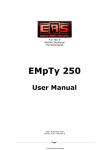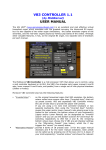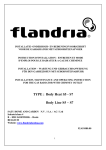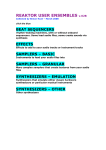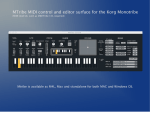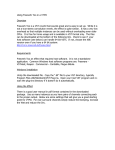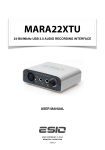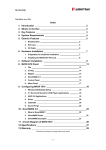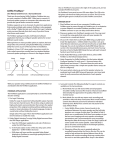Download EMpTy 250 - Empty Room Systems
Transcript
P.O. Box 9 9620 AA Slochteren The Netherlands Evalutionversion EMpTy 250 User Manual Date: November 2010 Version 2.00 – Revision A Page 1 © Empty Room Systems 1. Introduction Thank you for testing the Empty 250 in evaluation mode. The demo has a limited functionality and limited time use (max 31 days). The official fully functional and not time limited version can be downloaded at our website: www.emptyroomsystems.com. The Empty Room Systems EMpTy 250 VST plugin has been developed to sound like the first digital reverb in history, the EMT-250. This reverb is known for its warm sweet sound and has been used on thousands of recordings worldwide. Only 250 of these machines were ever built and they are now museum pieces, needing to be handled with care. To make this sound available to a lot of studios at affordable price Empty Room Systems made this plugin and made it available in VST format so it can be used in a lot of popular Digital Audio Workstations, like Cubase, Reaper and Nuendo. In this manual you will find information on the history of the EMT-250, the history of this plugin and information how to install it on your DAW. There is also a list with specifications, tested software and legal information. 2. How to install the plugin - Unzip the files you downloaded from the Empty Room Systems web site. You can use your favorite unzip-program or Windows built-in ‘compressed folder’ functionality to do this (right-click on the .zip-file and select “Extract all…”) - Start EMpTy250.exe. The installer will open and start copying files to the directories needed. - Windows Vista or higher may ask you for admin permissions to do this. Please click Continue if asked for these permissions. 3. How to activate - Start the host software and try using the plugin. In some host software this will require the user to “scan for new VST plugins” or similar action, other host software may try to open plugins right after it’s started up. Check the manual of your VST host software. After the plugin is started for the first time an activation screen will appear that looks similar to this: Page 2 © Empty Room Systems In the case of the demo it is not possible to activate it for more then 31 days. If you want to use the full possibilities of the EMpTY 250 you need to deinstall the demo version and install the official release. Please note: Make sure nobody sets your computer clock back to a date or time prior to installation, doing so will deactivate the software even after you set the computer clock back to its original date and time. - If you run into any trouble during installation, registration or afterwards, please e-mail a clear description of what happens to [email protected] and we'll try to solve your issue ASAP. Please mention the following if you e-mail for support: - VST host software you are using, including version Operating system you are using, including Service Pack version CPU and RAM specification Type of motherboard, if known, or brand and type of PC Type of audio hardware and driver version Page 3 © Empty Room Systems 4. How to use EMpTy 250 v2.0 Frontpanel 4.1. The plugin has four major controls and two smaller ones. From the left to the right the big handles with the round knobs control the following parameters: - Reverb decay time (from 0.4 to 4.5 seconds) In evaluation mode: 0.8 s, 1.5 s, 2.5 s Low response (x0.5 = half the reverb time, x2 = twice the reverb time at lower frequencies, etc.) In evaluation mode 1.0x, 2.0x High response (the way the decay is handled at higher frequencies) In evaluation mode: max, 0.33x Pre-delay (the time before the reverb starts in milliseconds). You can use it to set the reverb apart from the source. The small sliders at the bottom are enhancements to the original design. - With the left slider you can control the frequency of a low pass filter. Moving the slider to the left makes the reverb sound darker. The right slider is a mix control. Use this to set the balance between unprocessed input signal and processed signal – in other words, use this to determine how much reverb you want to add. The red REV button can be used to turn the effect off and on. It’s on by default, when you click it the plugin will go into bypass mode and forward any incoming signal to its output without any processing. The “LED bar” meter on the left monitors input signal provided to the plugin. When the Alarm LED lights up the level of the input signal is too high and nasty-sounding digital clipping may occur in the plugin. It is best to set the send levels in your DAW that the levels on the left side are in the green (-12 to -3 dB) range. Page 4 © Empty Room Systems The yellow SET button can be used to open a new set of controls on the backpanel. 4.2. Backpanel The backplate of the EMpTy 250 V2.0 gives a new range of controls. You can use the switch “vintage”and “modern” between the classic and the modern version of the reverb. These versions are based on the same algorithm, but have different qualities. While the Vintage version sounds close to the hardware EMT-250, the modern version is richer sounding on melodic instruments. On the right there is a switch that controls the front/back outputs of the EMpTy 250. These have different soundcolours. The front outputs are more the face sounding with more early reflections while the back outputs sound more distant. These also work this way on the 5.0/5.1 channels. With the 5 sliders the volume of the left, right, center left and right surround channels can be changed. On the left are the “Led bar”and the “Rev” knob that work in the same way like on the front panel. This also counts for the mix slider. The back switch brings you to the frontpanel. 5. Parameters of the EMpTy 250 reverb Reverb (short for reverberation) is a very commonly used effect in recording and mixing that places instruments, vocals or sounds in a room or hall. In the early days of recording reverb was made by recording the sound of an actual room using speakers and microphones or placing microphones at a large distance from the sound source. To simulate this, digital reverb adds this effect using calculations done on the original signal. This is called DSP – Digital Signal Processing. The biggest Page 5 © Empty Room Systems advantage of DSP’s over real spaces is the easy way of changing the room sound without physical changes. To get the sound of a tiled room it is easy to change the sound of a digital reverb, but in a real room you would have to place actual tiles in the room. When working on a mix of recorded material several kinds of digital reverb can be added to the material so it does or does not sound like it was played in a real room, bottom line being that its creative use can greatly enhance the listening experience. The reverberation in a real room has several phases: - The initial silence, called pre-delay - The early reflections, these are the first reflections of the sound waves bouncing on the walls, floors and ceiling of the room and reaching the ear. These reflections will be separately perceived by the ear in the beginning of the reverb sound. - The tail of the reverb (decay). The amount of reflections increases with time (the first reflections are being reflected again and again) while their loudness decreases. These reflections cannot be heard separately because they mix with each other in random ways depending on many different factors like frequencies present in the signal, room structure and size, damping or resonances in the room etc. Pre-delay The pre-delay is an important property. Basically, it represents the physical distance between the signal source and the space around it or, put in other words, how deep a performer or instrument is in a room. The position of a performer in the space can be altered by changing this parameter. It is possible to change this parameter in the EMpTy 250 reverb to mimic real spaces, but it can also be used for creative purposes. Silence can be an amazing tool in music. For example, with a long pre-delay it is possible to add a reverb with a long decay to a vocal, thus creating a nice atmosphere, while still being able to keep the words from the lyrics intelligible. It can be used in a creative way to make a large pre-delay in a room with a small reverb decay, which would not be possible in a real room. Early reflections The amount , spread of the early reflections in the in the EMpTy 250 cannot be changed, just like on the first hardware digital reverb, the EMT 250. The colour of the early reflection can be changed, by togling the front to back switch. Reverb tail (decay) There are three controls that influence the reverb tail. The most important one is the decay time. Setting it short will give a room like response. Setting it longer will create a hall sound. The decay algorithm in EMpTy 250 is a socalled constant density type, where randomizers help to create varieties in the reflections. Without these randomizers in delay time and amplitude the reverb sounds metallic. The sound of the reverb tail can be further altered using the decay controls for the higher and lower frequencies. In a real large room the decays in the lower frequencies are longer than those in the higher frequencies. This is Page 6 © Empty Room Systems because most damping materials in real spaces dampen higher frequencies better than lower frequencies. So the controls can be used to lengthen the decay in the lower frequencies and shorten them in the higher frequencies. The high response control has a maximum setting at which the reverb can sound quite sharp to imitate bright-sounding rooms. The low response control has a setting at which decay times can be shortened. This helps with material that has a lot of low frequency content. It can help cleaning up low frequency content from the reverb tail when needed. Low pass filter A lot of digital reverbs have a low pass filter to filter away sharpness from digital colorations. It also dampens the emulated room sound. We added a sweepable filter in the EMpTy 250 as an extra control for the high frequency content in the reverb tail. Moving the slider to the left makes the reverb sound darker. 6. Software compatibility The Plugin has at the moment of writing been tested with the following systems: - Nuendo 4 Nuendo 3 Nuendo 2 Reaper Samplitude Wavelab 6 Adobe Audition 3.0 VSThost The plugin is known to be working under Windows XP Pro Service Pack 2 and Windows 7. 44.1/48/88.2/96kHz, mono, stereo, 5.0 and 5.1 operation are tested and supported. 7. System requirements The computer on which the plugin is installed needs to meet the following specifications or better: - Pentium 4 or higher class computer - 1 GB RAM - 1 GB free hard drive space (more recommended ;) - Windows XP - 1024 * 768 pixels 16 bits screen – higher resolution and color depth recommended (the plugin has been developed on 1920 x 1200 screens) - VST host software Page 7 © Empty Room Systems 8. Legal terms and conditions Empty Room Systems have made their best effort to build reliable and high quality software. However, this software is provided on an "As is" basis without a warranty of any kind, including without limitation the warranties of merchantability, fitness for a particular purpose and non- infringement. The entire risk as to the quality and performance of the software is borne by the buyer. Should the software prove defective, you assume the entire cost of service and repair. Under no legal theory tort, or contract or otherwise will the company be liable to you or any other person for any indirect, special, incidental or consequential damages of any character including damages for loss of good will, work stoppage, computer failure or malfunction or any and all commercial damage loss. In no way will Empty Room Systems or their employees or contractors be liable for damages in excess of the list price for a license to the software even if Empty Room Systems has been informed of such danger, or for any claim by other parties. The software described in this document is subject to a license agreement and may be activated on only one physical computer per license purchased. Empty Room Systems owns the copyright of the software, a buyer only buys a license to use the software. The software may not be reverse-engineered or otherwise modified. If you do not agree with these terms, Empty Room Systems can only refund you if you provide proof that you de-installed the software, such proof being in a form that Empty Room Systems approves (like for example a license removal code). All product and company names are trademarks of their respective owners. The information in this document is subject to change without notice and does not represent a commitment on the part of Empty Room Systems. No part of this publication may be copied, reproduced or otherwise transmitted or recorded without prior written permission by Empty Room Systems. 9. Support For support or questions you can: - - send e-mail to [email protected] write to: Empty Room Systems P.O. Box 9 9620 AA SLOCHTEREN The Netherlands Page 8 © Empty Room Systems








